Part 2B – Baby’s Journey
Vaginal Birth – Placenta to End of Acute Recovery Phase
SEPTEMBER 23, 2021 BY JULIANA PARKER, RNC-OB, C-EFM
Do not consider the opinions expressed here as medical advice (click to read more)
All of the content provided on the website are for informational purposes only and DO NOT CONSTITUTE THE PROVIDING OF MEDICAL ADVICE and are not intended to be a substitute for independent professional medical judgment, advice, diagnosis, or treatment. IF YOU HAVE A MEDICAL EMERGENCY, CALL YOUR DOCTOR OR 911 IMMEDIATELY. To read the entire disclaimer, click here.
Your baby’s journey from the delivery of the placenta to the end of acute recovery is action packed and has a few similarities to mom’s journey. As we continue this What to Expect AFTER Giving Birth – A Comprehensive Guide we will review all of the expectations in your baby’s journey those first few hours right after birth.
In this segment, we will be discussing:
Skin-to-Skin
Your baby’s individual journey begins when their cord is cut and mom and baby are officially separated. Skin-to-skin is a great way to start their new life. It provides an amazing transition from the intrauterine to the extrauterine world.
The benefits of skin-to-skin are incredible. Some of the benefits include keeping your baby warm, calming and relaxing both mom and baby, regulating your baby’s heart rate and breathing patterns. In addition, baby’s who are placed skin-to-skin feed better and for longer periods of time. I encourage everyone, if possible, to place their baby or babies skin-to-skin after birth. Partners, skin-to-skin is a great way for you to bond with your babies as well!
Warmth is incredibly important for newborns and since your baby just came out of a 98.7 degree environment and entered into a 70-degree room, we need to make sure they don’t become cold. Babies are born with very little extra fat (aka glucose storage). If your baby becomes cold, they have to use their limited glucose storage to keep them warm. Using too much storage can make them hypoglycemic, a potentially serious complication that requires treatment. Therefore, starting your baby’s journey with skin-to-skin can help your baby stay nicely warm and cozy with your warm body. As a result, this helps stabilize their temperature and glucose levels avoiding unnecessary interventions. One full-hour of skin-to-skin immediately after birth is recommended.
IMPORTANT NOTE: A nurse, at some point, will ask to take your baby to the baby warmer (in the labor room) to perform their assessment, obtain their weight, measurements, give them their medications. You can say yes, which will temporarily interrupt skin-to-skin or you can request that they perform their assessment, weight, etc. later. Also, many baby procedures can be done while your baby is in your arms. I will note them as you keep reading.
Apgar Scores
Apgar scores are an assessment of your baby’s health at 1 minute and again at 5 minutes from the moment they are born. Five categories are assessed with the potential of earning two points for each category. This assessment can be done while you are holding your newborn.
Heart rate is the first category assessed. Your baby’s heart rate, if above 100 beats per minute score two points. Below 100 beats per minute, they receive 1 point and if absent, 0 points.
Breathing is another category. Baby’s who make good efforts to breath, have a good cry, normal respirations, score 2 points. Slow or irregular breathing or weak cries receive 1 point and no breathing 0 points.
Muscle tone is the next category. Baby’s making active, spontaneous movements score 2 points. Little movement may receive one point and “floppy” babies receive 0 points.
Reflexes are next. Baby’s who cry, pulls away or sneeze with stimulation, receive 2 points, if they only grimace, they receive 1 and if they don’t respond, they receive 0 points.
Skin color is saved for last because most babies lose points on this category. Your baby, even if screaming at birth will likely still be somewhat blue at one minute, so they typically lose at least 1 point, sometimes they get 0 points at one minute. After five minutes of crying, their hands and feet typically remain blue and they usually still lose a point for this.
In conclusion, don’t expect a 10 for your baby’s Apgar score at 1 minute or at 5 minutes. A 9 is typically the highest score we see.
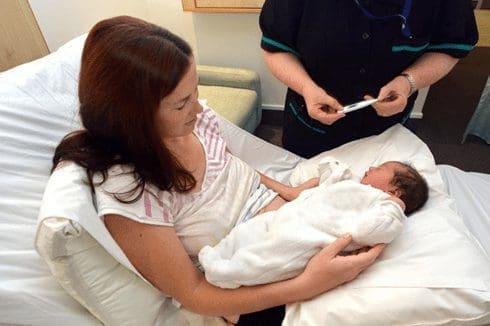
Vital Signs
Vital signs are an important way for us to be sure that your baby is doing well. Most facilities implement a protocol where vital signs are checked every 30 minutes for the first two hours of their life. After this, depending on whether your baby had any risk factors or based on your hospital’s protocol, vitals may be checked every 4 hours, every 8 hours or every 12 hours.
Remember, your baby’s temperature is very important. Be sure you or your partner remain skin-to-skin with your baby or have the nursing staff show you how to appropriately bundle your baby to ensure warmth.
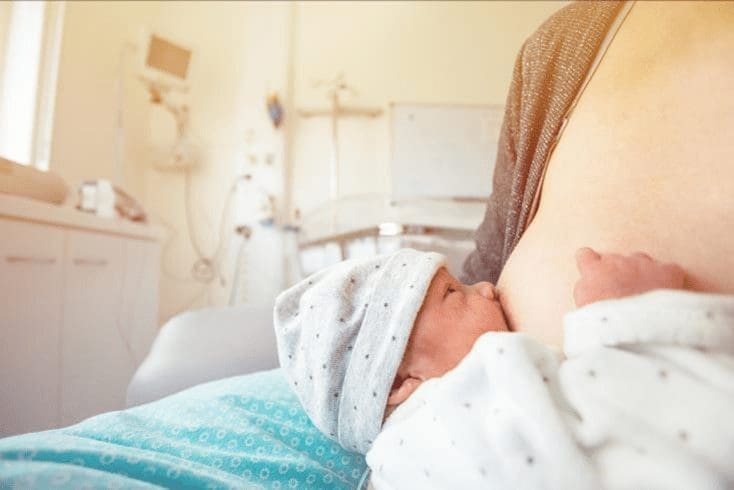
Breastfeeding
I have had the privilege of learning a lot about breastfeeding from experts. In addition, I have also had the privilege of assisting over 4,000 moms latch and feed their babies. Helping new moms get on the right path is one of my specialties. To learn all of my tips and more, sign up for my Breastfeeding Success class.
Here are a few to help you get started. First, if no one has offered to assist you with latching your baby within 30 minutes of birth, please be your own self-advocate and ask for assistance. Your baby should at least attempt to latch within the first hour if at all possible.
Second, it is okay if your baby does not latch. Sometimes they don’t right away. It may take some time. You are learning and they are learning. Try not to become anxious about this. There are other ways to feed your baby with your breastmilk if your baby is not latching right away. Ask your nurse about hand expression of breastmilk. No pump is required.
Golden rule, baby should be tummy to tummy with mommy. Your baby’s head and neck should be straight and in alignment. This means you do NOT hold their head to latch them, you hold their neck which by default, supports their head.
Your baby’s nose should be across from your nipple. You want your baby to lift their head up. Think about when we drink a glass of water, our chin does not get closer to our chest, it lifts towards the ceiling. Watch a short 50-second VIDEO about this concept here.
Formula Feeding
If you are planning to formula feed, check with your hospital to be sure they have the formula you prefer. Ask for a Volufeed or order them online.
When you add a nipple to a pre-mixed bottle of formula, it is very easy to overfeed your baby as they will just keep eating until the bottle is done. Newborns, when they are born, have a stomach about the size of a grape. They do not need large amounts of formula, check with the nurses to ask how much you should initially be feeding your baby.

Assessment
At some point, one of the nurses in the room will ask to do an assessment on your baby. Please know that this does not have to be done immediately unless there is a medical necessity, such as your baby is having difficulty breathing. You can delay the assessment.
The assessment is a full body check. We literally count fingers, toes, check for skin tags, bruises, birth marks. In addition, we look a their head, eyes, ears, mouth, bones, make sure their arms and legs are moving equally. Finally, we listen to their heart, lungs, abdomen, check their spine and every other body part.
There are times when we may notice something, like a birth mark or a 6th digit. These are not emergencies and do not require the baby to be separated from you. Just something we make note of and notify the neonatologist about so they can later assess.
Your baby will be assessed multiple times while in the hospital by the nurses and the doctors. The initial assessment does require the baby to be on the warmer under lights so we can clearly see everything. But remember, this can be delayed. If you would like to do skin-to-skin and breastfeed first, you can request that the assessment be done later.
Vitamin K
Babies receive a shot of Vitamin K in their thigh within the 1st hour of birth. This can be done while you are holding them.
This is their very first newborn shot, seems like not a very nice birthday present, but it is for their health and safety. Babies are typically born deficient of Vitamin K. A lack of vitamin K can cause them to bruise or bleed more easily and puts them at risk for a fatal bleeding disorder called Vitamin K Deficient Bleeding, also known as VKDB. Most VKDB cases involve bleeding in the brain and brain damage.
So while this may seem like we are being meanies, a quick boost of Vitamin K can easily prevent the possibility of this very harmful or fatal bleeding disorder.
Erythromycin
Babies are given a ribbon of erythromycin ointment in each eye after birth. This too can be done while you are holding your baby.
Erythromycin is given to prevent any bacterial infections to the eyes that may have been picked up during the birthing process. This sometimes will cause your baby’s eyes to look red and swollen but not to worry, it will resolve itself shortly after.
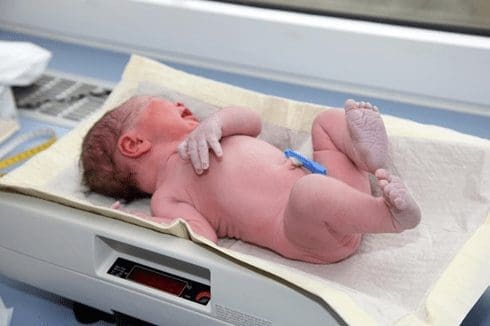
Weight and Measurements
Now it’s time for the fun details! Weighing and measuring your baby. If this is your first baby, remember that they typically have a cone head which means as the swelling reduces, so will their length.
Your baby does have to taken to the baby warmer to obtain their weight and length. Have your cameras ready, it’s a great photo opportunity! It’s also fun to take guesses before the final weight is revealed!
Weighing and measuring can also be delayed after skin-to-skin, but if you are really excited to know this, the nurse can do a quick weight and length check while the doctor is repairing you.

Footprints
Bring your baby books! Footprints by the nurses are the best! Since we do this several times per week, nurses are really good at getting your baby’s footprints. Most nurses are willing to footprint multiple items for you, so be creative! Some fun ideas?
- Greeting cards for out-of-state grandparents.
- A shirt that can be your partner’s official “baby” shirt that they only wear on delivery day. (Don’t wash it, the ink will wash out).
- A baseball
- A blank canvas for picture or wall framing
- A jewelry box
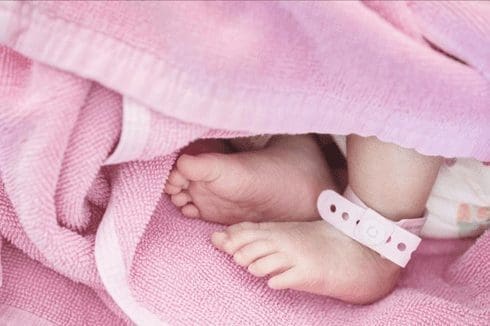
Security Tags and Bands
Your baby will be banded with two bands. There are two companion bands that will match. One for you and one for your partner/support person. If no other person is there, the 2nd band will be destroyed.
These bands are VERY important. If they come loose on you, your support person or your baby at any time, notify your nurse immediately so they can be replaced. If your support person is going home, they should not remove the band. The band can be left on during showers.
These bands have an individual printed number on them and are used to identify you as the baby’s caregivers. This means when we match the numbers, we will leave the baby with you. If you don’t have the band, the baby will not be left with you until identification is confirmed.
If your baby goes to the nursery for an assessment or procedure such as a hearing test, make sure your nurse matches your band numbers before taking the baby and again when your baby returns. This is a MUST. Any nurse who does not do this is not doing their job and is in violation of hospital policy, so do not be afraid to speak up to the nurse and say, you need to check the bands.
Another good idea is to read your band number to your nurse. If they instead read it to you, you may be half asleep, your eyes may be foggy and you may be agreeable to anything that sounds close. But by you reading your band number to your nurse, it places the responsibility on your wide-awake nurse to ensure the number matches.
Sleep
Your baby may be exhausted from today event’s. After a feeding, it is fine for your baby to rest on you or your partner skin-to-skin or in a crib. Use a crib if you are feeling sleepy. You should not hold your baby while you are sleeping nor should you keep your baby in your bed.
Baby’s rest, while important, should not be prioritized over their meals. Many babies are very sleepy the first 24 hours after birth. As a result, you may need to make extra efforts to make sure they don’t miss a meal.
Babies should be eating approximately every 3 hours. This means you may need to make some efforts to wake your baby for feedings over the next 24 hours. Ask your nurse for assistance, if needed

Educational Opportunities
While in labor and delivery, everything can be a whirlwind, but I like to mention the educational opportunities that you should take advantage of while on this unit.
First, swaddling. This is your first opportunity for you or your partner to ask how to swaddle your baby. Each nurse may teach you a different trick so take the time to ask and then ask them to watch you do it. The more observed practices you can get prior to discharge the more skilled you will be.
Second, holding. If you have never held a newborn baby before, do not be shy! Speak up and let your nurse know. Ask, “Can you show me how to properly hold a newborn?” It’s scary at first, but once you get used to it, it won’t be so intimidating.
Third, breastfeeding. Not every nurse is a certified lactation consultant, but labor and delivery nurses help new mothers with breastfeeding on a daily basis.
IMPORTANT TIP: Be a self-advocate. If a nurse has not offered to help you breastfeed within 30 minutes, be sure to ask for help. In addition, if the nurse tells you that your baby has a good latch, ask them how they know that. “Can you show me how you know this is a good latch?” If your nurse says it’s a bad latch and we should unlatch and restart, ask, “Can you show me how you know this is a bad latch?” The more you learn, the better prepared you will feel once you go home.
Unexpected Scenarios
Every now and again, a baby has to be taken to the NICU for observation or admission. It can be devastating for the new parent to be separated from their baby.
While some babies need just a little transition time and come back within 1-2 hours, other babies may need more extensive care and may be there for several days.
Ask your nurse to take you to the NICU before transferring to postpartum. The NICU nurses, if at all possible, will help you with skin-to-skin and feedings.
Once you are moving around on our own, you should be able to visit your baby whenever you like.
Conclusion
As you can see, the first two hours after you give birth are action packed for both you and your baby. In our upcoming segments, we will be discussing C-Sections recoveries, the next few days in the hospital, and preparing for your emotional and physical recovery
Did you miss a part of our Comprehensive Recovery Guide? Use the links below so you can learn more!
Part 1: Vaginal Birth to the Delivery of Your Placenta
Part 2A: Mom’s Journey (Vaginal Birth) – Placenta to End of Acute Recovery)
Part 2B: Baby’s Journey (Vaginal Birth) – Placenta to End of Acute Recovery Phase
Part 3: Cesarean Birth to Delivery of Your Placenta (coming soon)
Part 4: Cesarean Birth – Placenta to End of Acute Recovery Phase (coming soon)
Part 5: Non-Acute Recovery to Discharge Home (coming soon)
Part 6: Preparing for Your Emotional Recovery (coming soon)
Part 7: Preparing for Your Physical Recovery (coming soon)
Featured Courses

The Childbirth Master Class
If you are pregnant and want a vaginal birth, with or without medication, then start here. Learn about the entire birthing process including all interventions and ways to increase your chance of success!

Elementary Newborn Care
If you have little or no experience with babies, then you won’t want to miss this program. We will cover everything you need to know about your newborn from simply holding to changing diapers!
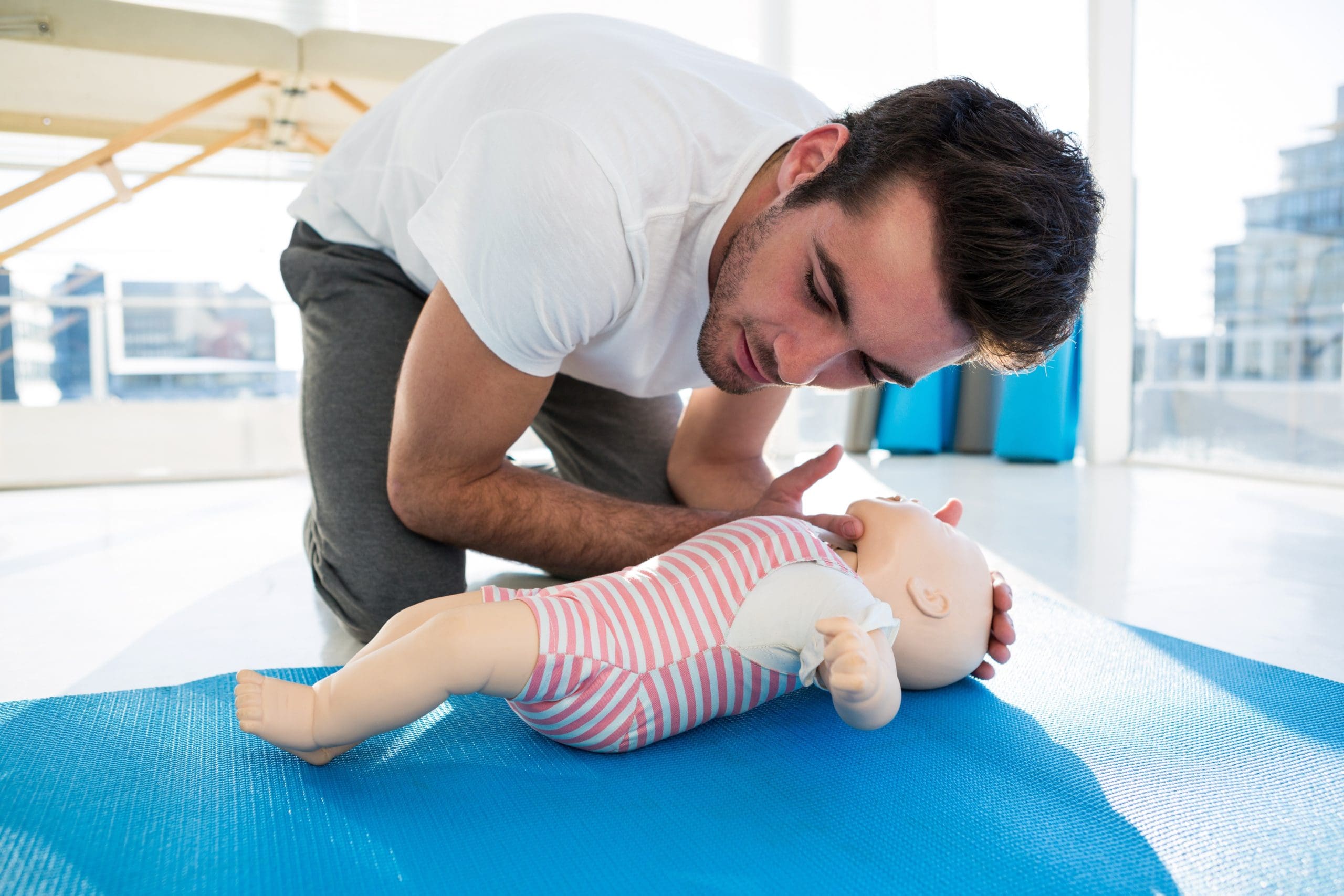
Childproofing and CPR
Learn to set up a safe environment, avoid unintentional accidents and manage emergencies. You’ll learn how to save a life in less time than it takes to watch a great movie!

